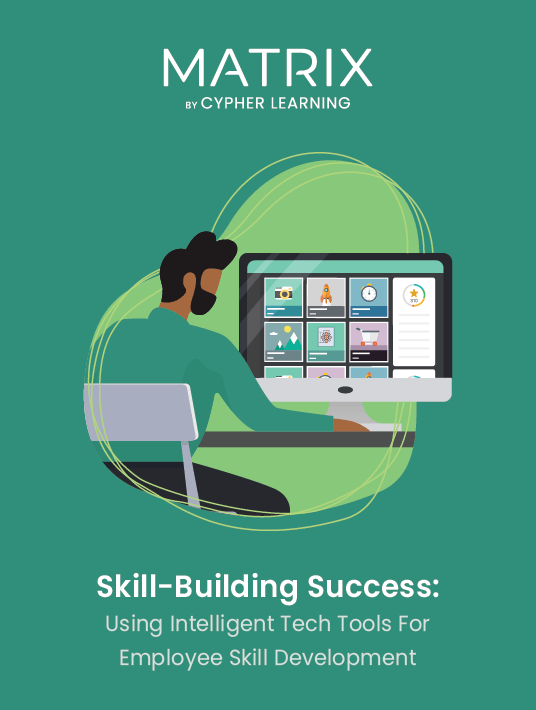How Can You Improve The Employee Journey With Automated Recommendations?
Modern employees expect a seamless and personalized learning journey. They prefer an accelerated learning path that resonates with their job duties, roles, and responsibilities.
Meanwhile, instructors also have a lot on their plate, including administrative tasks. Taking the time to offer personalized recommendations for each employee is not even an option. This perpetuates the cookie-cutter training model for the sake of practicality.
That’s why automated recommendations are a much better solution. They are instant, widely available, and can be set up in minutes or hours since they rely on artificial intelligence (AI).

What Automated Recommendations Can Do To Enrich The Employee Learning Journey
1. Define Job Roles And Competencies
Each job can have different associated competencies. For example, a Senior Graphic Designer needs communication, strategic thinking, creativity, and leadership skills. Each skill can be broken down into SMART (Specific, Measurable, Achievable, Relevant, and Time-Bound) learning objectives.
Companies can choose to define the roles and competencies that matter most to their employees and organizational goals. This means that they eliminate unnecessary information and learners automatically receive the best training resources for bridging skill gaps.
2. Use Employee Surveys
Although automatic recommendations are fast and effective, employee surveys still have a role to play when it comes to diagnosing training needs. They allow instructors to gather feedback from all learners at once or at a departmental or team level. They can also be anonymous, so learners will feel comfortable giving honest feedback.
Based on these surveys, instructors can decide what type of training is best suited for employees’ needs, what are their learning preferences, and what skills they should focus on the most. For instance, most learners may prefer micro-courses for skill development since they can easily fit them into their busy schedules.
Then, instructors can also use employee surveys to fine-tune the types of automated recommendations learners should get.
3. Configure The Recommendations Engine
A recommendations engine is an intelligent learning platform feature that allows instructors or managers to configure what type of training resources to show employees. For instance, the recommendations engine can be tweaked to include only self-paced courses since they are what employees need at the beginning of their training.
However, companies can also expand their definition of “training resources” to include digital media such as online articles, PDF files, audio-only podcasts, and more. A special resource is “contact a mentor” who is an expert in their learning goal/subject area.
Customizing training resources allows companies to control the recommendations that learners automatically receive without limiting them too much.
4. Create A Rich Content Library
A rich content library means that there is something for everyone, no matter their learning goal. Consequently, companies need in-house and third-party training material to bridge skill gaps.
Company-created courses generally address topics such as branding, internal processes, and specific skills employees need to thrive in the organization. Third-party content providers offer many skill-based training materials that don’t depend on what the organization does. For example, to learn how to create an effective presentation, all they need to do is access an Udemy course that the platform recommends.
5. Offer various opportunities for skills development
Skills development is not a one-size-fits-all solution. That is why personalization is so important. Learning paths are a significant part of training personalization. Moreover, the second best practice is to provide a wide variety of course styles — instructor-led, self-paced, micro-courses, etc., so each learner can select the most appropriate.
For instance, employees who prefer social learning experiences can choose an instructor-led online course complete with synchronous sessions. Others may need self-paced modules because they are more independent learners and prefer to have a list of tailored and curated recommendations.
6. Enable instant learner feedback
Learner feedback is instrumental when it comes to choosing training resources. First and foremost, it’s important to encourage employees to rate the resources and leave reviews after completing online courses.
Moreover, they can also rate automatic recommendations, which also helps others choose the best content for them. In this way, employees can make a quick decision when accepting training recommendations. They don’t have to rely on instructor input whenever they need to fill in learning gaps.
7. Bridge skill gaps
Once the platform understands the goals and job roles, it’s easy to identify skill gaps for each employee. The process is straightforward: instructors use competency-based learning to associate training resources with competencies they should teach. Afterward, as learners complete modules, they also take assessments in the form of quizzes, essays, discussion participation, etc. If they perform below a certain threshold, such as below 70% for a specific competency, it means that there is a skill gap that needs to be addressed.
Therefore, the platform instantly recognizes these skill gaps and automatically recommends content that can help employees improve their skill levels. Only then can they move on to the next stage and learn another competency. The cycle repeats until they feel confident enough in their skills.
Key Takeaways
Automatic recommendations based on job roles and competencies are essential for creating a system that works well and works faster than in a regular training environment. Instead of relying solely on surveys to bridge skill gaps, instructors can measure these in real-time through competency-based learning. Once a skill gap is identified, the platform automatically sends the best recommendations out of hundreds or even thousands of training resources so learners can focus on improving their skills as soon as their performance drops.
Download the eBook Skill-Building Success: Using Intelligent Tech Tools For Employee Skill Development to learn how you can use modern technology to fuel employee growth. You can also join the webinar to discover how to create effective skill development programs for employees.









